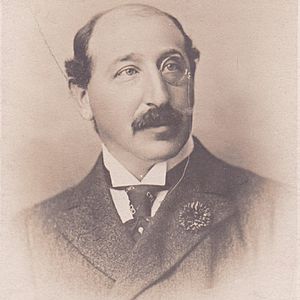Herbert Raphael facts for kids
Sir Herbert Henry Raphael (born December 23, 1859 – died September 24, 1924) was a British politician and a lawyer. He was also known for his work in town planning and his service during World War I. He came from a family of bankers.
Herbert Raphael studied in Germany and Switzerland before going to Trinity Hall, Cambridge in England. There, he studied law and became a lawyer in 1883. However, he soon decided to focus on public service and politics instead of practicing law for long.
Contents
Herbert Raphael's Political Career
In 1889, Herbert Raphael was elected to the first London County Council. This was a local government body for London. He was part of the Progressive Party, which was supported by the Liberal Party and controlled the council. He also served on the London School Board, which managed schools in London, and later on the Essex County Council.
Raphael tried several times to become a Member of Parliament (MP). He ran for election in Romford in 1892 and 1897, and in St Pancras North in 1900, but he did not win these elections.
His fourth attempt was successful in the 1906 United Kingdom general election. The Liberal Party won many seats that year. Raphael became the MP for South Derbyshire, winning against the previous MP. He held this position until the 1918 United Kingdom general election. In 1911, he received a special title and became a baronet.
Town Planning Work
In the 1890s, Herbert Raphael lived in Essex. From 1897, he owned a large area of land called Gidea Hall, which was about 480 acres.
From 1910, Raphael began to develop his land into a special type of community called a garden suburb. This area is now known as Romford Garden Suburb in Gidea Park. He worked with two other MPs on this project. In 1911, an exhibition was held in Romford to show off the new ideas in town planning. Famous architects, known for their work in the Arts and Crafts Movement, designed buildings for this suburb. The idea was to create well-planned communities with green spaces. A park and an avenue in the suburb, Raphael Park and Raphael Avenue, are named after him.
War Service in World War I
At the start of the 20th century, Raphael was part of a volunteer army group called the 1st Volunteer Battalion, Essex Regiment. When World War I began, he joined the army as a private soldier in the 24th Sportsman's Battalion, Royal Fusiliers.
In June 1915, he became an officer with the rank of major. He then helped create a new army unit, the 18th (Service) Battalion (Arts & Crafts), for the King's Royal Rifle Corps at Gidea Park. Later that year, he helped form another unit, the 23rd (Reserve) Battalion. He served as the second-in-command for both of these units. Towards the end of the war, he worked as an Assistant Provost Marshal in Folkestone, Kent, which involved military police duties.
Art and Public Service
Herbert Raphael was very active in public life. He served on several committees and was a trustee of the National Portrait Gallery. This meant he helped manage the famous art gallery. In 1916, he donated several paintings and portraits to the National Gallery.
He was also a governor of Guy's Hospital, helping to oversee the hospital's operations. Additionally, he was a justice of the peace for Essex and Derbyshire, which meant he was a local judge who handled minor legal matters.
Family and Later Life
In 1884, Herbert Raphael married Rosalie Coster. They lived near Folkestone. Raphael enjoyed sports, especially shooting. He died suddenly in September 1924, at the age of 64, from heart failure while out shooting on his property. He did not have any children, so his special title of baronet ended when he passed away.


